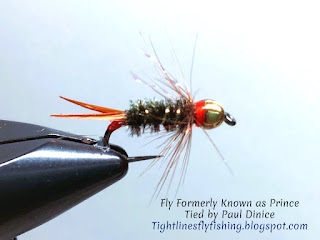The Fly Formerly Known as 'Prince'
Hook: Tiemco 3769 Size
#10-#18 or preferred Nymph Hook.
Bead: Gold Bead to match hook size.
Thread: Orange or Red UTC 70
Denier.
Tail: Brown Goose or Turkey Biots. Also a ‘tag’ of Orange or Red Thread.
Rib: Gold or Silver Oval Tinsel.
Body: Peacock Herl.
Collar: Natural Partridge or Brown Indian Hen.
Wings: Large Silver Holographic Tinsel or 2 Strands of Pearl Krystal Flash (It’s what I use and prefer).
If you fish the Housatonic, you definitely want to have a Prince nymph in your box. The addition of a ‘Flash’ wing can sometimes increase the productivity of the ‘Prince’ nymph.
To tie this fly begin by placing your bead on the hook and your hook in the vice. Start your red thread behind the bead and take some securing wraps. Cut off the tag end and make touching wraps down shank and halfway down the bend. The red thread will serve as a tag on the fly. Next, tie in two Brown or Tan Goose Biots for the tail. Match the Biots so that they splay outward. They should extend approximately ½ hook shank beyond the bend. After making a few securing wraps, adjust the Biots so that they extend symmetrically beyond the hook bend. After trimming off the butt ends of the Biots, bring your thread up behind the Bead. Tie in your Oval Tinsel and wrap down to the bend.
Next, tie in 3-6 Strands of Peacock Herl at your Biot tie in
point. Bring your thread up behind the Bead,
leaving a little ‘eye length’ space.
Wrap your Peacock Herl forward using touching wraps to create the
body. Tie it off and cut off the butt
ends. Now, palmer and counter wrap your
Rib forward and tie it off. Cut off the
butt end. Next, tie in your Collar
feather by the tip. Trim and cut off the
tip. Using your hackle pliers, take 2-3 ‘wet
fly’ wraps around the hook shank. Stroke
the feather fibers back as you wrap. Capture
and tie off the stem with a couple wraps.
Cut off the excess. You are now going to tie in your Holographic Tinsel
or Krystal Flash wings. Normally on a ‘Prince
Nymph’ the wings would consist of White Biots.
The flash wings supercharge this fly.
I prefer to use Pearl Krystal Flash for the wings. Tie your wings in behind the bead. They should extend slightly beyond the
body. Tie them off and whip finish the
fly, creating a small hot spot collar behind the bead.
InTheRiffle has a great video on how to tie this fly below:
If you have any questions about this fly or would like to submit a Fly of The Month I can be reached at pdinice@frontier.com .




